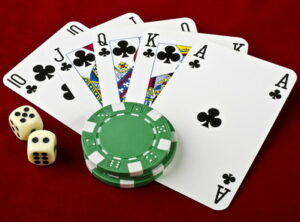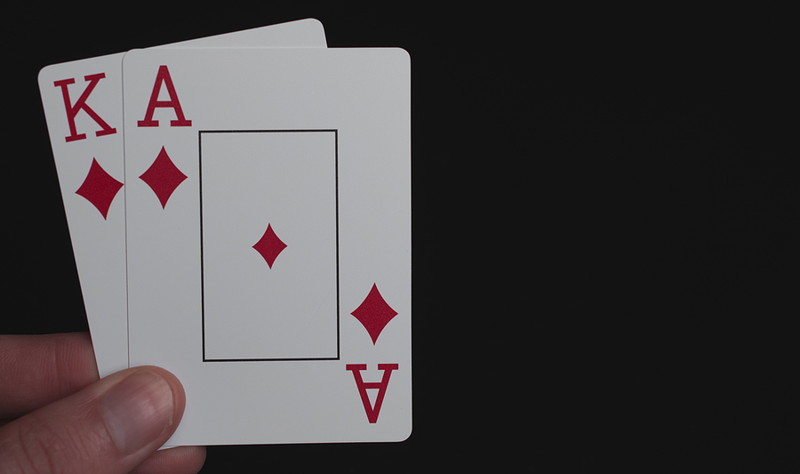 In all versions of poker, including Hold’em poker, a flush is a hand lying somewhere at the middle of the hand ranking, between a straight and a full house. Despite this we often chase a flush draw and it sometimes appears to be desired by players more than a full house.
In all versions of poker, including Hold’em poker, a flush is a hand lying somewhere at the middle of the hand ranking, between a straight and a full house. Despite this we often chase a flush draw and it sometimes appears to be desired by players more than a full house.
There are psychological reasons for that: having several cards of the same suit in hand or as a hand grants that hand an aesthetical element that potentiates the illusion that the flush draw is both valuable and easily achievable with the next one or two cards.
This might not happen for instance with one or even two pairs waiting for a full house. Moreover, a flush is automatically associated with the straight flush, the “king” of the hands, which is another reason for loving the flush.
Obviously, a full house is harder to hit than a flush, since the former stands higher in the hand ranking, and a straight flush is even harder. However, many players overestimate subjectively the strength of their hand when a flush draw is in progress.
In this article we shall see what the precise flush odds are and how to evaluate the advantage of a hand with suited cards relative to a flush draw in every stage of the game.
Flush odds at the flop stage
 Among all card odds in Hold’em poker, flush odds are known as the easiest to compute, at least for your own hand. That is because the combinations that are counted are only formed with one kind of cards, namely those of that particular suit.
Among all card odds in Hold’em poker, flush odds are known as the easiest to compute, at least for your own hand. That is because the combinations that are counted are only formed with one kind of cards, namely those of that particular suit.
However, things can get complicated also for flush odds if we try to work out the odds that one or more of your opponents will hit a flush or beat your flush if achieved; that’s because higher flush, full house, quads, and straight flush odds – hands that can beat your flush – come into the equation.
Let’s get started with the simplest odds
 In the flop stage, you can hit a flush by river only if a minimum three cards of a suit are visible (on the board and in your own hole cards together). There are two probabilities associated with this event, namely 4.16% or 34.96% (if three or four cards of the suit are visible, respectively; the event includes hitting a straight flush).
In the flop stage, you can hit a flush by river only if a minimum three cards of a suit are visible (on the board and in your own hole cards together). There are two probabilities associated with this event, namely 4.16% or 34.96% (if three or four cards of the suit are visible, respectively; the event includes hitting a straight flush).
Of course, the most advantageous configuration is that in which your hole cards are both of that suit. Otherwise, the chances that one or more of your opponents will also hit that suit increase, since they use the community cards as well.
Precisely, the odds that at least one opponent will hit a flush by river, computed at the flop stage, are given in the next table, where n is the number of opponents, s is the number of visible cards of that suit and s’ is the number of visible cards of that suit in the community cards.
| – | s’=0 | s’=1 | s’=2 | s’=3 | ||||||
|---|---|---|---|---|---|---|---|---|---|---|
| s | 1 | 2 | 3 | 2 | 3 | 4 | 3 | 4 | 5 | |
| n | ||||||||||
| 1 | 0 | 0.277% | 0.184% | 0.117% | 3.515% | 2.606% | 1.860% | 19.409% | 16.048% | 12.895% |
| 2 | 0 | 0.546% | 0.365% | 0.233% | 6.359% | 4.777% | 3.454% | 30.402% | 23.533% | 20.998% |
| 3 | 0 | 0.806% | 0.542% | 0.294% | 8.595% | 6.894% | 4.439% | 37.557% | 32.861% | 26.517% |
| 4 | 0 | 1.059% | 0.714% | 0.459% | 10.373% | 8.053% | 6.890% | 41.889% | 37.139% | 32.376% |
| 5 | 0 | 1.303% | 0.882% | 0.569% | 12.041% | 9.350% | 7.057% | 45.721% | 40.553% | 35.631% |
| 6 | 0 | 1.539% | 1.046% | 0.677% | 13.610% | 10.579% | 7.945% | 49.129% | 43.599% | 37.987% |
| 7 | 0 | 1.767% | 1.206% | 0.783% | 15.081% | 11.738% | 8.819% | 52.117% | 46.276% | 40.314% |
| 8 | 0 | 1.987% | 1.362% | 0.887% | 16.455% | 12.871% | 9.678% | 54.685% | 48.903% | 42.610% |
| 9 | 0 | 2.200% | 1.493% | 0.990% | 17.832% | 13.794% | 10.524% | 57.514% | 50.894% | 44.874% |
We can see in the table that there are situations in which the odds for your opponents to hit a flush by river are relatively high.
For instance, three cards of the suit on the board and one in your hand gives to six opponents about 43.60% chances for hitting the flush. The lowest odds for the opponents are in those configurations where only one card of your suit is on the community board, ranging from 0.1 to 2.2%.
The most advantageous situation relative to flush, except hitting it in flop – when you hold two cards of that suit and other two cards are on the board, giving you about 35% odds of hitting it by river – gives your opponents odds ranging from 1.8 to 10.5% (depending on their number).
These odds only measure the event ‘hitting the flush by river’ and not ‘hitting a higher flush’. Depending on how high are ranked the values of the cards in your suit, the odds for your flush to be beaten (if achieved) may be slightly lower or higher than those in the table above.
The same assertion applies if considering other possible suits, for instance in a configuration where the board consists of cards of two or three symbols (2 + 1 or 1 + 1 + 1 as symbols).
The odds for your opponents to hit a second and even a third suit (if possible) can be also picked by using the table above, then added to the odds for the initial suit.
Example:
- Community cards: (♣♣♥)
- Your own hole cards: (♥♣)
- 6 opponents
You target the flush draw of ♣. Let us see what is the probability for at least one opponent to achieve a flush of ♣. We have s’ = 2, s = 3, and n = 6. Searching in the table, we find the probability 10.579%.
But your opponents may also hit a flush of ♥ (if one holds ♥♥ and the turn and river cards are of ♥). We have now s’ = 1, s = 2 and the table gives the probability 1.046%.
Overall, there is 10.579% + 1.046% = 11.625% probability for at least one opponent to hit a flush by river.
Advantage relative to flush in the flop

However precise these long-shot odds are, they can dramatically change with each next card to come on the board – in fact, this accounts for the beauty of Hold’em. Therefore, the balance ‘own hand odds vs. opponents odds’ for a flush in the flop stage cannot be taken as an absolute measure for the strength of your hand relative to flush, even more so as an absolute strength.
With the turn card, both you and your opponents’ might consider other draws beside flush (involving card values and not symbols), which add to the strength of the hand.
However, poker is a game where it’s actually this apparent advantage (real or fake) that is played at moments before the showdown, regardless on how the odds for that advantage to be maintained or improved change with the next stages of the game.
The advantage is a result of a more or less objective estimation of the strength of your own hand, but it is an objective criterion of play in itself, given the rules of poker.
In what concerns the flush-draw advantage, it can be accounted for in the flop stage easier than for other draws. Flop is the stage offering the least information for the long-shot probabilities of hitting the target draws (with two cards to come), so the evaluation of the current advantage (or disadvantage) that the card configuration gives to your hand is as important as those probabilities.
However, the flop odds are in general the hardest to compute (some of them impossible), from the same reason. Besides computation, it is actually impossible for a player to memorize full tables of odds covering all possible configurations, one for each draw, for your own hand, and for your opponents; this also applies to flush odds, regardless of the easiness of computation.
Therefore, in the flop stage evaluation of the advantage is essential, and this can be done in a simplified mode, not by taking into account the long-shot odds, but the odds that your opponents hold (at that particular moment) certain configurations of cards that gives them either the same, a higher or a lower advantage than the advantage that your own hole cards plus the board give to your hand.
Your advantage relative to flush is measured by probability (there is no other objective measure for that), namely the probability that no opponent holds a more advantageous configuration relative to flush (that is, giving them better odds for hitting the flush by river).
For the flush draw, the possible configurations can be reduced to a few categories of situations (five), which can be easily memorized along with their associated odds:
1. No suited cards on the board, two suited hole cards matching one symbol on the board. Example: (♥♣♦ the board) and (♥♥ hole cards).
Probability that one opponent holds two suited cards matching one symbol on the board (giving them the same advantage as yours) is 16.37%, increasing with the number of opponents. Overall, you have 100% advantage over your opponents relative to flush, no matter their number, as there is no way for them to hold a better configuration (two suited cards matching one symbol on the board).
2. Two suited cards on the board, non-suited hole cards, of which one matching the board suit. Example: (♣♣♦) and (♣♥).
In this configuration, an opponent holds a better configuration than yours if they hold two suited cards matching the suit on the board. Your advantage depends on the number of opponents, as follows:
| No. of opponents | Probability of their advantage | Your advantage |
|---|---|---|
| 1 | 4.16% | 95.84% |
| 2 | 8.32% | 91.68% |
| 3 | 12.48% | 87.52% |
| 4 | 16.65% | 83.35% |
| 5 | 20.82% | 79.18% |
| 6 | 24.84% | 75.16% |
| 7 | 28.96% | 71.04% |
| 8 | 33.08% | 66.92% |
| 9 | 37.18% | 62.82% |
3. Two suited cards on the board, hole cards suited matching the board suit. Example: (♦♦♣) and (♦♦).
This is the best possible configuration relative to a flush draw and you have 100% advantage over your opponents relative to flush, no matter their number.
4. Two suited cards on the board, hole cards not suited, matching two symbols on the board. Example: (♠♠♥) and (♠♥).
Your advantage in this configuration is slightly higher than in configuration 2), because for an opponent it is preferable to hold a suit with the unsuited card on the board as in configuration 2) than a suit with the less numerous symbol (♥♥) in the current configuration, since in the latter case you hold one of those cards (remaining fewer outs for the opponent).
5. Board suited, hole cards not suited, one of them matching the board suit. Example: (♥♥♥) and (♥♠).
In this configuration, an opponent holds a better configuration than yours if they hold two suited cards matching the suit on the board (i.e., they hit the flush). Your advantage depends on the number of opponents, as follows:
| No. of opponents | Probability of their advantage | Your advantage |
|---|---|---|
| 1 | 3.33% | 96.67% |
| 2 | 6.58% | 93.42% |
| 3 | 7.89% | 92.11% |
| 4 | 9.59% | 90.41% |
| 5 | 11.00% | 89.00% |
| 6 | 12.96% | 87.04% |
| 7 | 15.07% | 84.93% |
| 8 | 17.74% | 82.26% |
| 9 | 21.18% | 78.82% |
Summarizing these results, you have advantage over your opponents (whatever their number) in configurations 1 and 3, and your advantage depends on the number of opponents in the rest of the configurations. In these latter cases, the high percentage does not necessarily mean that your hand will win with that frequency, but is just an objective measure of your advantage.
Odds like 28-37% for your (7 – 9) opponents to have a better hand in the flop in configurations 2 or 4, or 21% for your (9) opponents in configuration 5, as seen in the above tables, are high enough to consider them in estimating your opponents’ chances.
In general, you should not take this probabilistically-measured advantage of your hand relative to a draw (flush, in our case) to be a decisive measure for the strength of your hand, nor the only criterion for a decision on betting/raising. The betting actions of your opponents count as well in adjusting this advantage – it is specific to poker. But there are other reasons, too.
First, remember that it is pure probability and not certitude. Second, a big amount of that percentage reflects the probability that your opponents hold a configuration as good as yours. The difference between the figures in the two columns of the tables represents the odds that your opponents hold a similar hand as yours.
For instance, in configuration 5 with 4 opponents, about 81% out of your about 90% advantage reflect this equal situation. It is also true that you actually hold that configuration and whether other opponents also hold it is uncertain, which counterbalances the previous concern. And third, depending on configuration, there may be other draws besides flush that may add to the overall advantage of your hand, but this also applies for your opponents’ hands.
For instance, the configuration (3♥ J♥ 10♦) and (9♥ 10♣) gives you not only a flush advantage, but the pair of 10s may evolve to trip/set or higher, and the open-ended straight may also evolve to straight in your favor. Each of these additional advantages (relative to each of those draws) can be computed, but it is more difficult than for the flush. Again, the same additional advantage may occur for your opponents’ hands, and can be measured based only on the information given by your hole cards and the board.
Flush odds at the turn and river
 In the turn stage, if you have a suit of four cards in your hand and on the board together, the odds for hitting a flush by river are the easiest to compute, as there is only one card to come and one symbol to count. You have just to divide the number of outs (9) to 46, the number of remaining cards and you get one single probability, namely 19.56%.
In the turn stage, if you have a suit of four cards in your hand and on the board together, the odds for hitting a flush by river are the easiest to compute, as there is only one card to come and one symbol to count. You have just to divide the number of outs (9) to 46, the number of remaining cards and you get one single probability, namely 19.56%.
Opponents’ odds for a flush (which are positive only if at least two suited cards are on the board) are given in the next table, where n is the number of opponents, s is the number of visible cards of that suit and s’ is the number of visible cards of that suit in the community cards:
| – | s’=0 s’=1 | s’=2 | s’=3 | s’=4 | ||||||
|---|---|---|---|---|---|---|---|---|---|---|
| s | 2 | 3 | 4 | 3 | 4 | 5 | 4 | 5 | 6 | |
| n | ||||||||||
| 1 | 0 | 1.086% | 0.790% | 0.553% | 11.469% | 9.327% | 7.377% | 48.813% | 44.426% | 39.795% |
| 2 | 0 | 2.139% | 1.562% | 1.097% | 20.167% | 16.674% | 13.408% | 68.272% | 63.382% | 57.996% |
| 3 | 0 | 3.160% | 2.315% | 1.384% | 26.381% | 22.548% | 17.340% | 78.909% | 76.406% | 71.257% |
| 4 | 0 | 4.147% | 3.052% | 2.158% | 30.749% | 26.555% | 22.504% | 83.108% | 81.826% | 80.499% |
| 5 | 0 | 5.103% | 3.770% | 2.675% | 34.746% | 29.995% | 25.557% | 86.326% | 85.130% | 84.739% |
| 6 | 0 | 6.028% | 4.471% | 3.183% | 38.510% | 33.175% | 28.049% | 88.739% | 87.608% | 86.434% |
| 7 | 0 | 6.922% | 5.155% | 3.682% | 41.784% | 36.096% | 30.505% | 90.347% | 89.260% | 88.130% |
| 8 | 0 | 7.778% | 5.821% | 4.173% | 44.829% | 38.953% | 32.924% | 91.152% | 90.913% | 89.826% |
| 9 | 0 | 8.618% | 6.381% | 4.654% | 47.987% | 41.220% | 35.306% | 92.760% | 91.739% | 91.521% |
Example:
- Community cards: (♣♣♣♥)
- Your own hole cards: (♥♣)
- 6 opponents
Let’s see what are the odds for at least one opponent to hit the flush of ♣ by river.
We have n = 6, s = 4, and s’=3, and the table shows the probability 33.17%. Of course, this probability also covers the event that an opponent already holds that flush.
With such straightforward probabilities for your own hand and for your opponents’ hands, which are relevant given the amount of information (6 cards) relative to the uncertain cards to come (one card), the evaluation of advantage as in the flop stage is no longer necessary. You can evaluate the strength of your hand relative to flush solely basing on these odds.
For the river stage, the odds that your opponents achieved a flush are given in the next table, with the same denotations. These odds may be used to evaluate the strength of their hands relative to flush even if you did not hit it.
For the case s’ = 4 with n > 3, we used an approximation method that returns numerical values within 1% error range (the approximated values appear in italics in the table).
| – | s’=0 | s’=1 | s’=2 | s’=3 | s’=4 | ||||
|---|---|---|---|---|---|---|---|---|---|
| s | 3 | 4 | 5 | 4 | 5 | 6 | |||
| n | |||||||||
| 1 | 0 | 0 | 0 | 4.545% | 3.636% | 2.828% | 36.363% | 32.727% | 28.989% |
| 2 | 0 | 0 | 0 | 8.949% | 7.188% | 5.609% | 60.555% | 55.673% | 50.458% |
| 3 | 0 | 0 | 0 | 13.216% | 10.656% | 7.075% | 73.779% | 71.440% | 66.099% |
| 4 | 0 | 0 | 0 | 17.346% | 14.042% | 11.032% | 79% | 78% | 77% |
| 5 | 0 | 0 | 0 | 21.343% | 17.346% | 13.675% | 83% | 82% | 82% |
| 6 | 0 | 0 | 0 | 25.209% | 20.570% | 16.271% | 86% | 85% | 84% |
| 7 | 0 | 0 | 0 | 28.947% | 23.714% | 18.823% | 88% | 87% | 86% |
| 8 | 0 | 0 | 0 | 32.560% | 26.780% | 21.330% | 89% | 89% | 88% |
| 9 | 0 | 0 | 0 | 36.040% | 29.355% | 23.792% | 91% | 90% | 90% |
Example:
- Community cards: (♣♣♣♥♦)
- Your own hole cards: (♥♣)
- 5 opponents
Let us see what is the probability for at least one opponent to hold a flush of ♣. We have s’ = 3, s = 4, and n = 5. Searching in the table, we find the probability 17.34%.
The conclusion and advice that we can draw from all these numerical results is that when it comes to a flush draw, it is better to trust the odds rather than immediate “feeling” or “intuition” when evaluating advantage.
Just looking in the last table at the river stage, if you hit a flush with all your hole cards and four cards of that suit are on the board, the odds for your opponents to hit it are between 50 and 90% for more than one opponent in play.
Even at the turn stage, having two suited cards in hand does not reduce much the chances for your opponents to hit the flush if more than three cards of that suit are on the board, and for 5 opponents up these odds are relatively high.
More so in the flop stage, any apparent advantage given by configuration is fragile and instable. This happens because unlike in other types of draws, the number of outs is much higher for the flush. Once you hit it or (apparently) are about to hit it, don’t rely on that every time, especially when many opponents are in play, as the chances may work almost symmetrically for them.
About The Author
The author of this page is Dr. Catalin Barboianu. Catalin is a mathematician specialising in gaming and responsible gambling and a research associate at the University of Bucharest.
